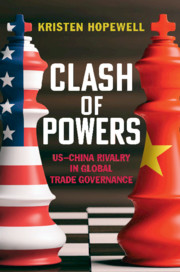Book contents
- Clash of Powers
- Clash of Powers
- Copyright page
- Contents
- Figures
- Tables
- Acknowledgments
- Introduction
- 1 The Doha Round Impasse
- 2 The New Politics of Agricultural Subsidies: A US–China Battle
- 3 The Dragon in the World’s Oceans: Fisheries Subsidies
- 4 Beyond the WTO: Erosion of the Export Credit Arrangement
- 5 Negotiating in the Dragon’s Shadow: Export Credit for Coal Plants
- Conclusion
- Notes
- References
- Index
Introduction
Published online by Cambridge University Press: 21 January 2021
- Clash of Powers
- Clash of Powers
- Copyright page
- Contents
- Figures
- Tables
- Acknowledgments
- Introduction
- 1 The Doha Round Impasse
- 2 The New Politics of Agricultural Subsidies: A US–China Battle
- 3 The Dragon in the World’s Oceans: Fisheries Subsidies
- 4 Beyond the WTO: Erosion of the Export Credit Arrangement
- 5 Negotiating in the Dragon’s Shadow: Export Credit for Coal Plants
- Conclusion
- Notes
- References
- Index
Summary
This chapter introduces the central argument and themes of the book and situates its contribution within contemporary debates regarding the rise of China and its impact on global economic governance. The book challenges two key prevailing views: (1) the US maintains its dominance in the international system, with China too weak to pose a serious threat to American hegemony; and (2) a rising China can be integrated into the US-led liberal international economic order. I argue that an important aspect of US hegemony to date—its ability to lead or dominate global institutions—has been severely undermined by the rise of China. If the US once “ran the system,” this book demonstrates the extent to which that has now been disrupted. China’s emergence as a counterweight to US power has sharply curtailed the US’s institutional or rule-making power. The US and China are engaged in a struggle over the rules of global trade, with each seeking to shape the rules to reflect and advance its interests. China has refused to defer to American power or simply be a rule-taker, but instead has repeatedly blocked the US from obtaining its objectives. US–China conflict is profoundly undermining global trade institutions and rule-making.
Keywords
Information
- Type
- Chapter
- Information
- Clash of PowersUS-China Rivalry in Global Trade Governance, pp. 1 - 29Publisher: Cambridge University PressPrint publication year: 2020
